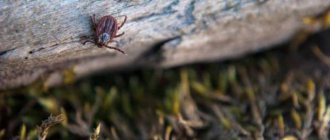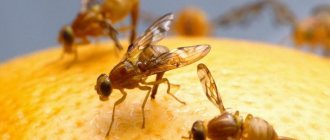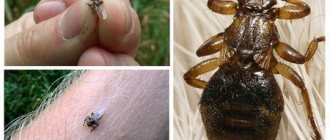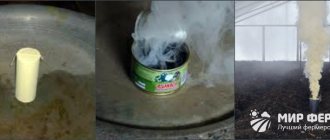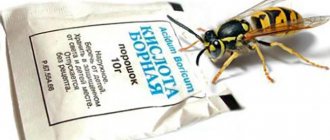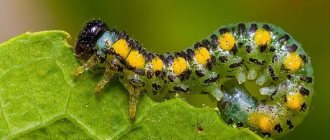Every gardener or owner of a summer cottage would like to grow aromatic, juicy grapes that they can show off to experienced agronomists. However, in reality, this process is very troublesome, since during the season you often have to deal with many difficulties, including pests. And one of the most common diseases is aphids. If you find these insects on the bushes, you should not panic, because grape phylloxera is easily defeated if you recognize the enemy in time and begin to act correctly, in a timely manner.
What does the leaf form of the disease look like?
Detecting aphids is quite easy if you pay attention and look closely at the plants. Specific galls on the leaves, resembling warty spherical formations, indicate that the grapes have leaf phylloxera. If the swellings are visible only on the lower side of the green mass, then this is a primary infection of the bush, and if on the upper side, then the larvae have already repopulated.
It is worth noting that the intensity of phylloxera development on plants can be different and directly depends on the immunity of the bushes and their age.
So, if phylloxera (growths on grape leaves) is clearly visible to the naked eye, the fight against it should begin immediately. However, experts also distinguish the root form of the disease, due to which the bushes slow down their growth, the leaves become small, and fruiting becomes scarce. Visually, the plant is simply depressed, and in order to establish the exact cause of its disease, you will have to take samples more than once for detailed study.
Conditions for its distribution
There are a number of factors that contribute to the spread of the pest in the area. These include:
- The tendency of a particular grape variety to phylloxera. European varieties are most defenseless against this pest, while American varieties already have immunity to it. There are phylloxera-resistant varieties.
- Vineyard age. The older the bush, the deeper it is rooted, the more resistant it is to the parasite.
- Soil type. The pest prefers loose soils.
If you find these insects on the bushes, you should not panic, because grape phylloxera is easily defeated if you recognize the enemy in time and begin to act correctly, in a timely manner.
It should be noted that climatic conditions have virtually no effect on the life activity of this parasite. It tolerates both high and low temperatures well and quickly activates when climatic conditions change to more comfortable ones.
Signs of defeat
If a vineyard is infected by a form of the pest that lives in the soil, the damage can be recognized by a sharp decrease in yield and gradual wilting of the bush. When digging up the plant, the gardener will also be able to find curved roots with knots (bite sites). The appearance of rot in the vineyard, damage to shoots.
This material will tell you about gray rot.
With the winged form of the pest, the main signs of damage to the crop will be galls on the leaves.
In some cases, the gardener may find the pests themselves in the vineyard (which is typical for the winged form of phylloxera). Typically, small insects can be found on the backs of leaves. They are easier to spot in dry weather.
How to recognize the root form of the disease
In order to identify the presence of aphids or traces of their presence on the root system, you need to dig up several suspicious vines or surface roots. Experts recommend performing the procedure in the second half of summer, since it is during this period that the pest actively reproduces and is easier to detect. The sample taken must also contain soil. Using a sharp thin knife or scalpel, carefully separate the lumps of earth and examine the contents of the cracks in the bark. If grape phylloxera is present on them, the winegrower will notice small swellings on small roots, and on thick ones - clusters of aphids resembling yellow spots. They will be round, no more than 1 centimeter in diameter. It is noteworthy that the affected root tips take on a hooked or club-shaped shape with yellowish-white nodules, which darken over time, disintegrate, and then become almost indistinguishable. The bark resembles a sponge, crumbles, and the root itself looks dried out.
At the very beginning of the disease, phylloxera on grapes is practically invisible and can only be detected in the fifth year, so the control digging procedure will have to be done annually. It is important to remember that insects most often live in areas bordering the source of infection, since they always leave completely diseased plants and reproduce on healthy ones. The pest is capable of settling both on the surface of the root and on parts located at a depth of just over a meter. For inspection, you need to select samples taken from living bushes.
Kinds
There are two forms of pest damage to grapes:
- Root. Most often it is found on the so-called dew roots, located in the most breathable layer of soil (at a depth of 25-30 cm). On thin young roots, swellings or nodules appear, on thicker ones - swellings, which subsequently crack. Through such wounds-cracks, pathogens, fungi and bacteria enter the plant, causing the roots to rot and die. If there is a lot of phylloxera, it looks like yellowish dust on the roots.
- Leafy . It develops on leaves, on the underside of which swellings appear - the so-called galls. These pest larvae penetrate directly into the mesophyll of the leaf. With severe infection, the leaves become deformed, curl, and fall off.
Depending on the type of grape on which phylloxera lives, it goes through a complete or incomplete development cycle. Let's take a closer look.
The homeland of phylloxera, when and where it was discovered
The homeland of the most dangerous quarantine pest is the southeastern part of the United States. It was most often found on wild shrubs growing in the Mississippi River basin. The first defeat of vineyards was recorded in 1868 in Europe. It is known from history that in the 19th century, grape phylloxera destroyed more than 6 hectares of plantings, and appeared in Russia in 1880. The great winegrower V. E. Tairov noted that aphids are the most terrible and persistent pest, since they live on roots and foliage, destroy bush after bush and bring only devastation and disaster everywhere. In the second half of the century, the pest appeared in the south of France and spread with extraordinary speed throughout almost all European regions.
It is worth noting that in a short period of time, phylloxera destroyed over 70% of vineyards around the globe.
Forum statistics
208878 Messages in 1637 Topics from 5643 Users. Last user: Lyudmila72 Last message: “Rooting wine cuttings...” ( Today at 21:35:32) Latest messages on the forum.
Now on the forum
58 Guests, 16 Users
Users in the last 15 minutes: Nadezhda Grig, Igor F., Elena Z, Cherkessk, Helga, Natalia Nikolaevna, S_ivanickiy, Kenig, Pioneer, Amber7394, Buba, Pitko, Sergey Chistokletov, igor222, Verona, DIL [Blocked] [Section Moderator] [Forum Moderator]
Maximum online today: 98 . All-time maximum online: 2758 (28 July 2021, 17:22:51)
Users who visited the forum in the last 24 hours
Total: 303
(Visible: 302, Hidden: 1) 1963, Nadezhda Grig, Igor F., Elena Z, Cherkessk, Helga, S_ivanickiy, Natalia Nikolaevna, Kenig, Pioneer, Amber7394, Buba, Pitko, Sergey Chistokletov, igor222, Verona, DIL, Sergey 1965, Mikhno Alexander, Vardan, nick041, Vadim, SvetlanaBondareva, Ilya 77, Vika, vlad51, Vladimir Kovba, Capricorn, mers, dralexk1, Quiet, Victor56, y_fed, Alexey Deminov, Nadymchanka, lomakin1969, rivaN, uzeir, Vladimir Berdnikov, Nikolay Lipunov, Gaivoronsky Yuri, Vyacheslav03, Vasily 53, Nikolay S., Sergey Sukhonos, Vladimir Valentinovich, DorontsovPeter, Filippov Oleg, freesia, Arnyusha, Antagonist, Vova Kapran, DED2, DSW, niy1, Marina Protasova, max2008-01, Ramiz, Dmitry 77, Natasha, Evgeniy52, Zaur, tsv, rasstroitel, nadia, Alexander48, Yuri 14, Chiganak, Eduard., Verbitsky E.I., Maximilian, Igor K, and.drew, Serzh1978, Andrey 31, Svetla777, Olegbabanin, Volodya R , Ivan Levin, Anatoly Evgenievich, ElenkaF, Grandfather Igor, Bublichenko Alexander M, Sergey Tashchiyan, Polyanina Ekaterina, Elvira2017, Leonidych, Naumov Igor, Igor Sergeevich, GregoryG, Andrey68, Taker, Valery Rastorguev, Sergey Lomonosov, Pioneer-2, Belgorodets, Vitaliy Borisovich, Lydia58, Vasily1111, Dayton, Scythian, Gheo55, Berry, Alexander_89, Lexa_kot, Alexander Vl., Valentina Ivanovna, therapist, Tatyana B, Soshnin Yura, Vladimir Buturlakin, Leonty Yarygin, Viknik, Igor 31, Cecet71, Nikolai.prok OPOV , weather forecaster, Andrey Lis , bursucok, MaxL, 77volt, Izhitsa, Svetlana Korotina, Snezhinets, Inna161, Evgen_Ev, vikbublik, Tatyana A., GALINA ANOKHINA, AndB, gardener, mystic69, Mikhail Alekseevich, AnatoliyArt, Svetlana Streletskaya, kvg, Grandfather Young , OlgaOs, vladimirM, Sergey 61, formula1, potap05, Denisovich, maxbul, Valerie, Hoyo, LOZA, marlin64, ArchangelMichail, kdm57, Realist, viktor_, hanter64, Yavgen3678, Alexander Sh, Gardener - amateur, thanatos, Vyacheslav-56, Delivered Oleg Ivanovich, rambo, bonami, Vasily V., Iv Iv, Marshal, Yura, Natalya1968, Antonk1983, G.V., Wintel, rog, Galina, 64nikolay64, Alexander47, 25nata35, Zinaida, Tatyana Provorova, Slyd, Vyacheslav³¹, Mikhail77, Rita , Henry, Alexander150, Mihalych., Roman Fedorovich, Dmitry Anatolyevich, Tatyana Volzh, Oleg34, irahelm, Den, Mikhail Shtukkert, Marina Krymskaya, sergei, alexsandr, Spartak, kosmos, krasnovlad1, Marishka, Mst, Gennady Gr., Vladimir Kostochkin, Vladimir-kanevskaya, AlexanderD, Alexander Zinoviev, neposny, VeraNiK, AAV, Zhorzhovich, TITOVA LYUBOV, Slavik, Chapai, IUP, SvetlanaV., Sergey2017, YurSanych, Anatoly Sivkov, Alexander Gai, Linx, Alexander 61, Enych, Efimych, Sasha57, Alexey Viktorovich, AndSanych, Kalevanych, zsb, Dmitry Belarus, Galinka, Kan-Temir, MikhAf, VDV, Alexey Agryzkov, yotmast, Serginio, Sergey Yuryev, NatalyaMed, Alex65, Mark, Armagnac, m2d, Guram, Zheka, Slavka, Evgeniy Golovin , Nikolay Vladimirovich, Vlad Tverskoy, Andrey76, TIS, Zayac, Sergey Alexandrovich, Alexey Ivanovich, ichtiandr, Timofey, NelyaS, N.A. Sokolov, Vyacheslav59, psv1960, ni, Lyubov S., Nikolay Mikhailovich, Vladimir Shilov, nau_63, Irene , Masha_gardener, Elektronik_t, acustik, , lena, Andrey gladilin, amelanchier, Burundukx, Liza, Alexander-ask-34, Vovka, Sergey 31, Polina77, Victor55, Sergei Vasilevi4, Pirko Alexander, Pavel 64, Erem, alexss, Volgar, Evgeniy30 , Antrikan, Alexander K, Gennady163, Keys, Evgeniy Nazarev, Sergey Eliseev, Casperzrq, Natasha N, , Igor Viktorovich, Vertuoz2, Ivan Shmelev, Morgana, Aleksei, 31rus, nicson7, VitaliySD, SANYCH, Salex
Lifestyle of root pests
The grape aphid has an extremely complex life cycle and is divided into the following forms:
- underground;
- ground;
- providing communication (winged).
Thus, absolutely all individuals of aphids that infect the root system are exclusively female. The insects are distinguished by the absence of wings, yellow-green coloration with small dark dots on the back. Their sucking proboscis extends from the head to the abdominal part of the body and is capable of piercing the roots of the bush to suck out food. Over the course of 4–6 weeks, females lay hundreds of yellowish eggs, from which larvae with a particularly long proboscis are born after 8–10 days. The pest of this form prefers to settle on old plants and overwinter on them.
It is noteworthy that the larvae that survive until spring are very resistant to cold, and fighting them will not be easy.
Preventive actions
The main method of preventing the appearance of a pest is the correct selection of seedlings. To do this you need:
- do not buy seedlings from farms in areas of severe infection;
- choose phylloxera-resistant varieties;
- make a choice in favor of grafted rather than native root crops.
Before planting, it is recommended to treat the cuttings for several minutes in a solution of insecticidal preparations.
It is important not to overdo it here: too strong a dose can cause harm, from which the plant will take several months to recover
Experts also give the following advice: if a seedling is suspicious, but the variety is valuable and you want to preserve it, you can plant it in a hole with sand and at the same time prepare a stable rootstock. Get vaccinated in a year.
As a preventive measure for root phylloxera, a technique called catarrhosis is used - removing all dew roots on the plant to a depth of 20-25 cm. This procedure is designed to stimulate the development of the root system and increase the bush’s resistance to adverse environmental factors.
Lifestyle of a winged form
At the end of summer - beginning of autumn, among the root aphids you can notice nymphs - thinner orange individuals with the rudiments of wings. They develop more actively in conditions of high humidity and certain weather conditions. The insects crawl to the surface and after the 4th molt they finally transform into a winged form with long tentacles, as well as well-developed eyes. Such a pest is already capable of flying short distances and laying unfertilized eggs on grape buds, the underside of leaves and loose bark. Smaller larvae grow into males who live only up to 10 days, since they cannot feed due to the lack of proboscis. However, after a single sexual intercourse, the female lays one fertilized egg, which will overwinter in the cracks and crevices of old wood.
Description of the insect
Larva
Pests have underground and leaf forms, as well as intermediate forms. Therefore, the life cycle is quite complex.
The larvae of the underground form are exclusively female. They spend the winter on the roots. When the soil warms up to +1 degree, the larvae awaken and begin to actively suck out the grape juice. If you dig up the rhizome of a diseased plant, you can see on it
bulges, nodules and growths. These are the consequences of bites.
The size of the insect in the larval stage does not exceed 5 millimeters. The body is round, yellow-green or brown, with black spots on the back. There is a long proboscis on the head. Limbs are short. There are no wings. During the entire period of growing up, insects molt four times.
The larvae of the terrestrial form (winged) have clear sexual differences.
Females emerge from large eggs, and males from small ones.
Body length in females reaches 5, in males 2.8 millimeters. The color of females is pale yellow. Males have a rich yellow body. During the entire period of growing up, four moults occur.
Leaf-shaped larvae develop with the onset of spring in growths on the underside of leaves formed due to the bites of adult individuals. They look like small aphids of bright orange color. The grown larvae crawl over the leaves, forming new hollow growths (galls).
Adult
In the underground form, females are wingless, no more than 1.35 centimeters long. Pale yellow or greenish in color. They have a long sucking proboscis. In the absence of males, females lay up to 800 small brown eggs. Embryo development lasts on average ten days.
In a year, the underground form can have five to six generations. The last generation of larvae, emerging from eggs in mid-summer, goes into wintering.
At the beginning of autumn, a special form of orange females with wings appears. Orange nymphs climb onto surface shoots and begin to lay eggs.
The size of the nymphs is up to 1 millimeter, the body color is orange or buff, the limbs are long. The wings are paired. With their help, females fly short distances and lay eggs of different sizes on the vine.
The terrestrial form is represented by individuals of both sexes. Body color is yellow. Adults lack wings and proboscis. They cannot eat, but live on average eight days. The main purpose is mating. The female lays a single egg in cracks in the bark, which survives the winter.
The gall or leaf form emerges from the eggs with the onset of spring warming. These are always female aphids. They are more often called ancestors.
They live only on American grape varieties. They feed on the juice of leaves. The affected areas of the leaf curl up around the aphid's body, forming galls. Females place a clutch of eggs in these cavities (up to 1200 eggs in favorable warm weather). Young aphids, emerging from the eggs after ten days, crawl onto young leaves and form new galls there.
From the second generation (in mid-July), among the leaf form of the pests, female individuals of the root form with a more powerful proboscis appear, which return underground.
Reproduction in the gall (leaf) and underground (root) forms occurs without the participation of males. Bisexual aphids are found only in the intermediate terrestrial (winged) form.
Lifestyle of leaf form
With the onset of spring, the female wingless aphid hatches from the winter egg, initially settling on leaves 1-6. Gradually it moves higher and higher, sucking all the juices from the top of the green mass. At the puncture sites, a green gall with a concave shape is formed, sometimes with reddish spots. In just a few weeks, the grape phylloxera lays more than 1000 eggs, from which, after 8 days, young individuals appear, settling on fragile shoots. The pest will quickly crawl up, and when the plant is already completely infected, it moves to other bushes. It is noteworthy that under favorable conditions, up to 5 generations of aphids can develop in one season. By autumn, the pest becomes even larger, its body is much stronger, and its proboscis is longer. Despite the fact that the leaf form dies along with the fallen leaves, such phylloxera on grapes tolerates control measures very steadfastly.
How to fight and get rid
The first steps are detection of the outbreak and quarantine. All damaged bushes must be destroyed. To do this, they call in SES employees who carry out deep treatment of the plantings with a large dose of carbon disulfide. This is the most effective remedy. Which, unfortunately, kills not only pests and their eggs, but also the vine.
Pollination of infected plants with small doses of carbon disulfide preserves the bushes. But not as effective. The insects disappear and the vineyard can be used for many years. But at the slightest violation of agricultural technology or favorable conditions for the reproduction of larvae, the problem arises again.
How does phylloxera spread?
Grape aphids of root, leaf and winged forms are capable of very active movement along green shoots, foliage and in the soil. Sometimes underground individuals find themselves on the surface, where they move for hours without food or rest at a speed of 3 cm per minute. Winged insects travel up to 100 meters. Also, grape phylloxera passively moves over long distances with currents of wind, mud or rainwater. There are known cases when the pest traveled about 30 kilometers. The person himself also contributes to the spread of the disease by purchasing contaminated grafting and planting material and treating healthy plants with dirty tools.
In addition, the pest is carried by wild animals and birds.
Causes of phylloxera
The causes of grape phylloxera are an infected seedling or an incorrectly selected variety for a given climate. The composition of the soil also matters.
On what soils does aphid infestation occur?
Loose soil is excellent for pest breeding. Sandy soil has a detrimental effect on phylloxera.
Conditions for the development of the parasite on grapes
Aphids reproduce well on varieties that are highly susceptible to this disease. These are mainly European species. In young vineyards with shallow roots.
Phylloxera is well adapted to any weather conditions
Distribution methods
The first method of propagation is passive: wind, heavy rains, which entail rain and mud flows.
The second is by humans: the use of infected garden tools, stakes, on shoes, when purchasing a plant infested with pests.
The third is the independent movement of parasites.
Why is phylloxera dangerous?
During its life, phylloxera primarily affects the root system, so the bush receives less nutrients every year or stops absorbing them altogether. Growths, nodules and nodules completely isolate the underground parts of the plant, as a result of which they die from starvation. Young bushes may begin to dry out 3-5 years after damage, and older bushes may begin to dry out much later. The shoots of weakened grapes do not have time to ripen, so they often cannot tolerate winter frosts.
If you look at the lesion, you will notice that its outline is oval in shape, because the pest spreads in all directions from the object of primary infection. How to treat grape phylloxera, and photos with a detailed description of the pest can be easily found in many sources, but it is best to purchase varieties resistant to the disease.
Prevention
Timely and competent prevention will help reduce the likelihood of phylloxera appearing on grapes. As for the main preventive measures, they will be as follows:
- deep planting of plant seedlings, mainly in sandy substrate;
- regular inspection of plants for damage;
- removal of damaged vegetative parts of the grapevine;
- periodically replacing the top soil layer with clean and sifted sand, even if signs of pests are not yet noticeable;
- disinfection of purchased young plants before planting them in the garden (HCCH emulsion is used, with a concentration of 24%);
- planting varieties resistant to phylloxera or grafting onto rootstocks from resistant varieties with developed immunity to the pest;
- carrying out flooding of the root system of plants in the cold season for 1.5-2 months, which should lead to the death of insects.
It is important to carry out prevention all year round, starting in early spring and continuing until the first cold weather.
What grape varieties are best to plant on the plot?
Since the pest primarily lives on American grape varieties, experts recommend growing European plant species by planting them in sand. It is also rational to switch to complex-resistant new varieties or hybrids of Save-Villars. It is also safe to use European grape varieties that are resistant to phylloxera at the time of grafting.
Recommended varieties of rootstock vines:
- Kober 5BB;
- Riparia x Rupestris 101-14;
- Riparia Gloire.
The roots of these plant species are resistant to rotting and do not die when infected with phylloxera.
How a grape bush is affected
The grape aphid has a proboscis with which it pierces the root tissue, secreting saliva. The enzymes it contains lead to the formation of deformations in the form of nodules and swellings at the injection sites. On the adventitious thin roots, so-called beaks appear - nodosites, which quickly die off. On more powerful roots, thick growths-nodules - tuberosites - are first formed, then cracks appear.
Nodules on the roots interfere with the normal nutrition of the root system: their absorption of nutrients is difficult, and can even be completely stopped. Thickened growths of nodules on thick roots can isolate entire groups of roots from the food source, which leads to their death and the inability of the bush to receive nutrients.
The cause of death of the root system is not only phylloxera. Saprophytic fungi and putrefactive bacteria enter the resulting cracks, which ultimately lead to rotting and death of the roots.
From the moment of infection with phylloxera until the death of a grape bush, it can take from 3 to 5 years for young plants. For older people, this period is longer and depends on climate, soil, and fertilizers. The time of death of the affected bush depends on the resistance of the variety, which is genetically determined.
This is what grape aphids look like
Traditional methods of combating phylloxera
Once grape phylloxera has been identified, the fight against it should begin immediately. If the spread of the pest is insignificant, then you can completely get by with improvised means. Thus, they try to wash away harmful insects with high pressure of water, after which they become prey for birds. The procedure should be done several times.
Also, many advise preparing various types of solutions:
- Soapy (dissolve 100 g of tar soap in 10 liters of water). It is possible to mix soap with a small amount of washing powder and detergent, but it is better to avoid products that are overly scented as they attract insects.
- From ash (1 glass per 5 liters of water and leave for 12 hours).
- From the peel of citrus fruits (boil 0.5 liters of crushed substance in 1 liter of water, filter and add another 10 liters of liquid).
- From the tops of nightshade plants (half fill a 3-liter bottle with finely chopped herbs and pour boiling water up to the neck. Leave for 24 hours, then add 1 tablespoon of soap shavings or powder).
- Tobacco (brew 1 glass of tobacco leaves in 5 liters of water, leave and strain).
In addition, many experienced winegrowers advise attracting beneficial insects and birds to the plantations and planting aromatic herbs or flowers next to the bushes.
Control measures
Today, the only effective and reliable method of combating grape phylloxera can be considered the use of a grafted crop.
Important! It is necessary to breed varieties resistant to the disease.
It is impossible to preserve the bush when fighting the root form, since the use of effective chemicals is difficult due to the underground lifestyle of the pest. Sick bushes cannot be treated; they must be uprooted and burned. Grapes cannot be planted in this place for 5 years.
For planting grapes, light sandy loam, sandy and loess soils are recommended, since the movement and reproduction of the pest is difficult in them. Grape phylloxera develops worse in such soils.
The following agrotechnical methods are used against phylloxera:
- During the cold season, the area is flooded.
- The top layer of soil is removed and replaced with sand.
- Mineral fertilizers are applied to improve the immunity of grape bushes.
- Remove surface roots.
Another important measure is dressing the planting material. You can do this as follows:
- Dilute 20 ml of Rogor, phosphamide or danadim in 10 liters of water at room temperature. Do this in a ventilated space outside the home, using personal protective equipment (goggles, respirator, gloves).
- Completely immerse the seedlings in this solution, placing them under pressure so that they do not float up. Leave for a maximum of 5-10 minutes.
- Put on rubber gloves, remove the seedlings from the solution and transfer them to a large new bag. There shouldn't be any holes in it, it needs to be sealed. Tie the bag, check for holes and pack it in another bag. Leave for 12 hours outside, away from residential buildings, or in a barn.
- Remove the seedlings from the bags, wash and plant.
Soil dressing with carbon disulfide, which was used previously, turned out to be ineffective.
Treatment with pyrethroids and organophosphorus preparations against leaf aphids gives insignificant results, while harming the environment and increasing the pesticide load on the vineyard.
Chemicals to combat phylloxera
Of course, not all summer residents believe in traditional methods of fighting aphids, so they prefer to purchase ready-made products in specialized stores. It is advisable to treat grape phylloxera with insecticides that are practically not washed off by precipitation and are absolutely safe for honey bees.
The most common drugs against aphids:
- "Fastak" (combined with other fungicidal and insecticidal agents);
- “Fozalon” (destroys aphids and protects plants for a long period, exhibits toxic activity even at low temperatures);
- "Actellik" (prevents reoccupation);
- “Kinmiks” (destroys adult phylloxera and all types of larvae);
- "Confidor" and "Bi-58" (destroy the leaf form of the pest).
It is also important to completely destroy foci of infection by using flammable, volatile carbon disulfide, which penetrates deeply into the soil. It is recommended to observe quarantine measures to protect other plants from aphids.



